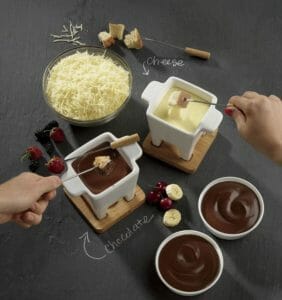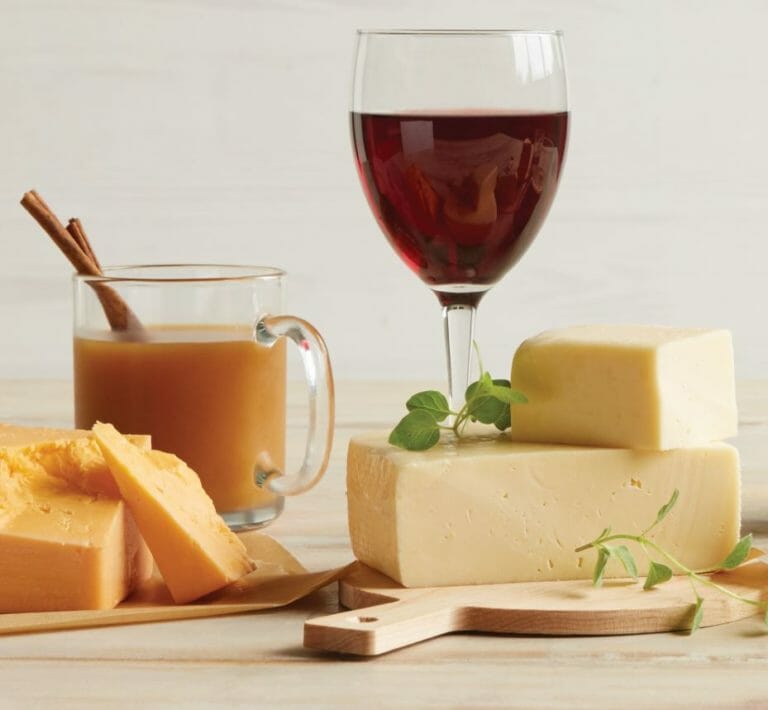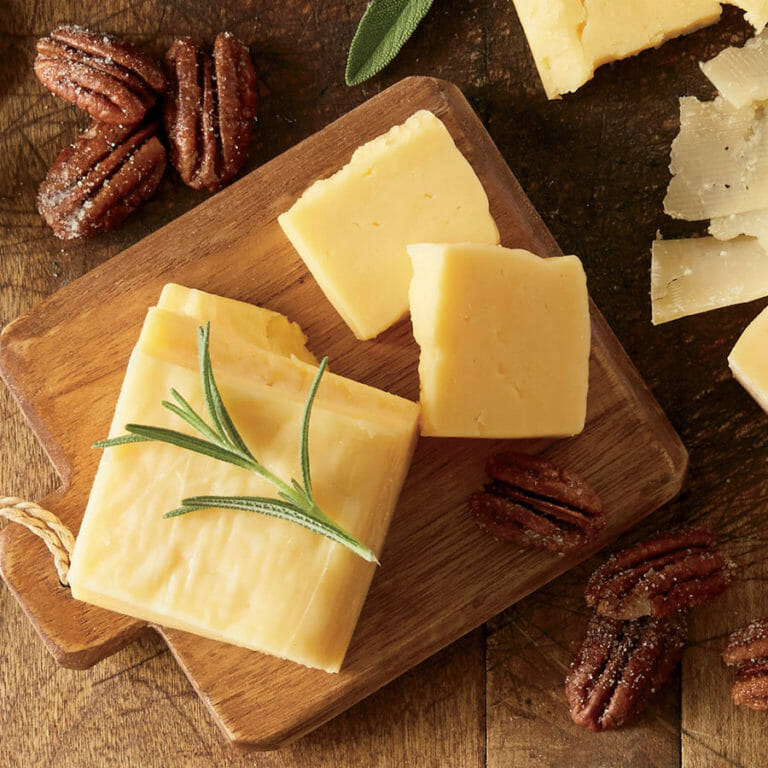The Best Cheese & Appetizer Pairings for Champagne
What is good to eat with Champagne? Put on a Champagne and cheese party to celebrate the New Year—or just because—with the best cheese for Champagne.
If you’re like many people, you’ll be celebrating the New Year with a glass of bubbly. Champagne—or sparkling wine in general—has been the toast of choice for special celebrations for centuries. Of course, around here no celebration is complete without cheese…and, after all, you’re going to need some food to go along with that beverage.

What Is the Best Food to Eat with Champagne?
It would actually take less space to list what isn’t good to eat with Champagne, since this wine with the bubbly personality gets along with a lot of foods. White wines tend to pair better with more foods than reds do, anyway. (Reds, of course, are great with food, but they’re more narrowly focused.) Whites—especially drier whites—have more acidity and a little bit of sugar. Also, there are the bubbles, which act as palate cleansers like a swig of club soda or mineral water would.
So what are the best foods with Champagne? Champagne is a versatile drink that pairs well with a wide range of appetizers. You want to choose foods or dishes that complement the light, effervescent taste of the wine. No doubt, the conversation really starts with fish, seafood, and other proteins.
Champaign Appetizer Pairings
- Oysters: Raw oysters are a classic pairing with champagne. Their briny, salty flavor complements the crisp, refreshing taste of the wine.
- Caviar: The delicate flavor of caviar pairs well with the light, effervescent nature of champagne. Serve with blinis and crème fraîche.
- Smoked salmon: The rich, buttery flavor of smoked salmon complements the light, crisp taste of champagne. Serve on crackers or baguette slices.
- Foie gras: The luxurious texture of foie gras pairs well with the effervescence of champagne. Serve on toast points or with a fig compote.
- Sushi: The delicate flavors of sushi, particularly sashimi, are enhanced by the crispness of champagne.
- Lobster & crab legs: Their richness (likely accompanied by drawn butter) is a perfect foil for the sparkling wine’s acidity and bubbles.
- Shrimp: the combination of Champagne’s acidity, sweetness, and effervescence with the delicate sweetness and umami flavor of shrimp creates a harmonious pairing that is both refreshing and satisfying.
- Cheese: Soft cheeses like brie, camembert, and goat cheese are great with champagne. Their creamy texture and mild flavor balance well with the acidity of the wine. More on cheese in a bit…
Beyond those staple appetizer pairings, you may also work with the following foods.
- Pasta and risotto: but only if you go with a creamy sauce like Alfredo. Add parmigiano reggiano cheese for the ultimate flavor. Stay away from tomato sauce, because the acidity will clash with that of the wine. A mushroom sauce is perfect, as Champagne (which is sometimes made partially with skinned pinot noir grapes) is a great match with earthy fungi.
- Fruits: What fruit goes with Champagne? Many! But the very best are berries (especially strawberries and raspberries) and stone fruits (peaches, plums).
- Other foods: salami, nuts (especially almonds), egg dishes (who can resist a mimosa with a cheese omelet?), popcorn, and potato chips (no, we’re not kidding).
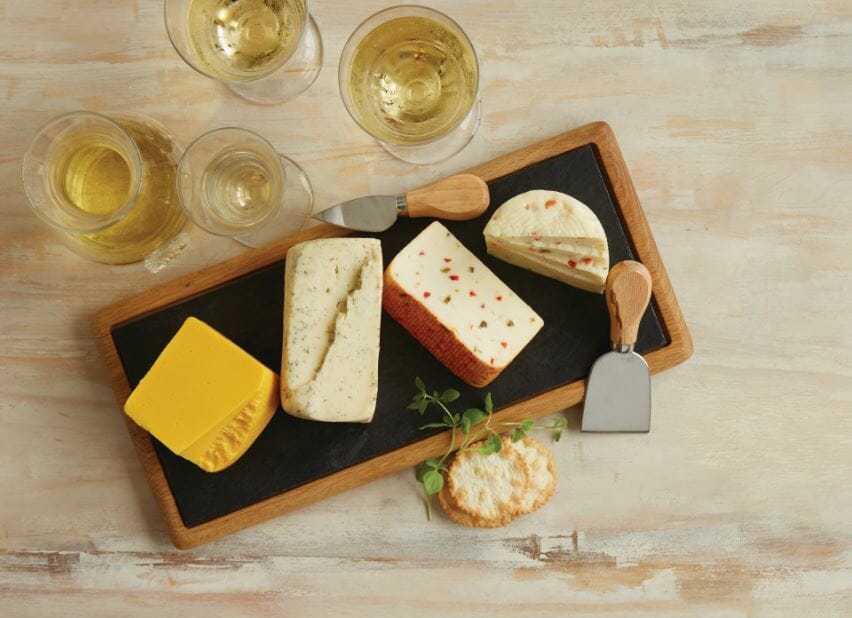
Sparkling Wine and Cheese Pairings
As noted above, Champagne pairs well with buttery and earthy foods. It stands to reason, then, that triple-cream soft cheeses would be the perfect match…and they are! But there are more great cheese pairings with Champagne and other sparkling wines.
- Brie: This creamy, buttery cheese is a classic pairing with champagne. Its mild flavor and soft texture complement the delicate bubbles and fruity notes of the champagne.
- Camembert: Similar to Brie, Camembert is a soft, creamy cheese that pairs well with champagne. Its earthy, mushroomy-flavor and creamy texture make it a great match for the crisp, effervescent bubbles of champagne.
- Parmesan: Hard cheeses like Parmesan can also be paired with champagne. The nutty, salty flavor of the cheese complements the crisp, acidic notes of the champagne.
- Gouda: This semi-hard cheese has a sweet, nutty flavor that pairs well with champagne. Its creamy texture and caramel notes add depth to the champagne’s fruit flavors.
- Roquefort: Blue cheeses like Roquefort can also be paired with champagne. The sharp, salty flavor of the cheese contrasts with the sweetness of the champagne, creating a complex, balanced flavor profile.
- Baby Swiss: with its lightly nutty and much more buttery flavor than aged Swiss, Baby Swiss is a natural partner for fizzy wines like Champagne, prosecco, and other sparklers.
- Colby: There’s something about Wisconsin’s original Colby cheese that makes it a definite winner with sparkling wines. Maybe it’s the mild flavor and lower acidity, or maybe it’s the tiny holes reminiscent of Champagne’s tiny bubbles. (You’ve got Don Ho stuck in your head now, don’t you? You’re welcome.)
Ultimately, the best cheese pairing with champagne depends on personal preference. Consider trying a few different cheeses to see which ones you enjoy most with your favorite champagne.
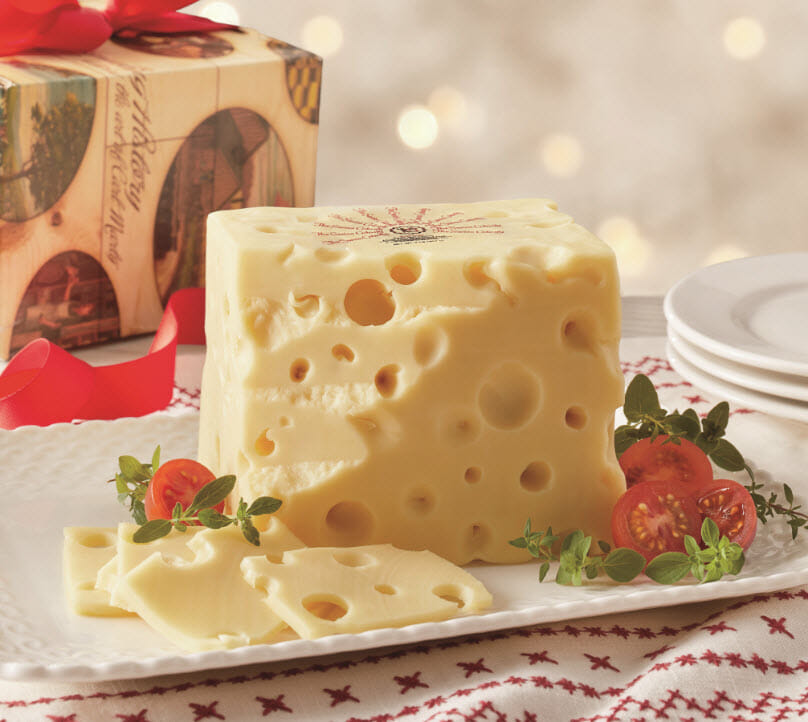
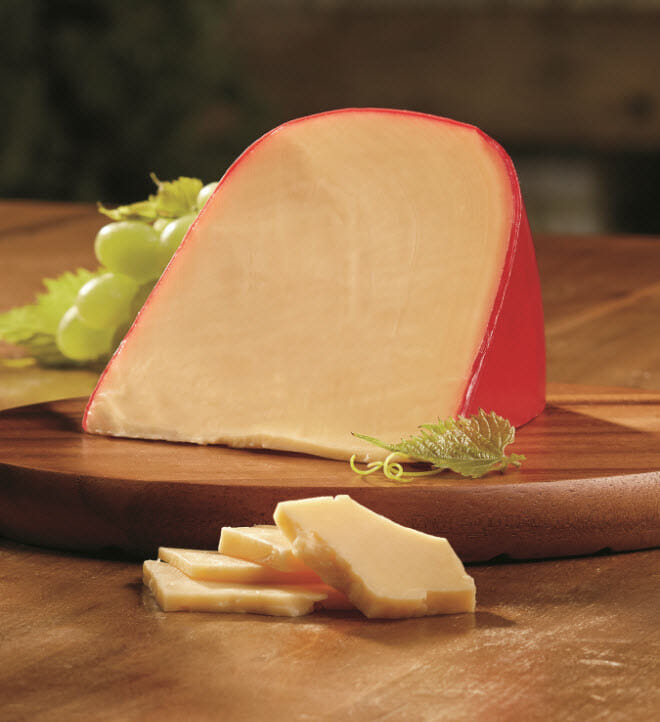
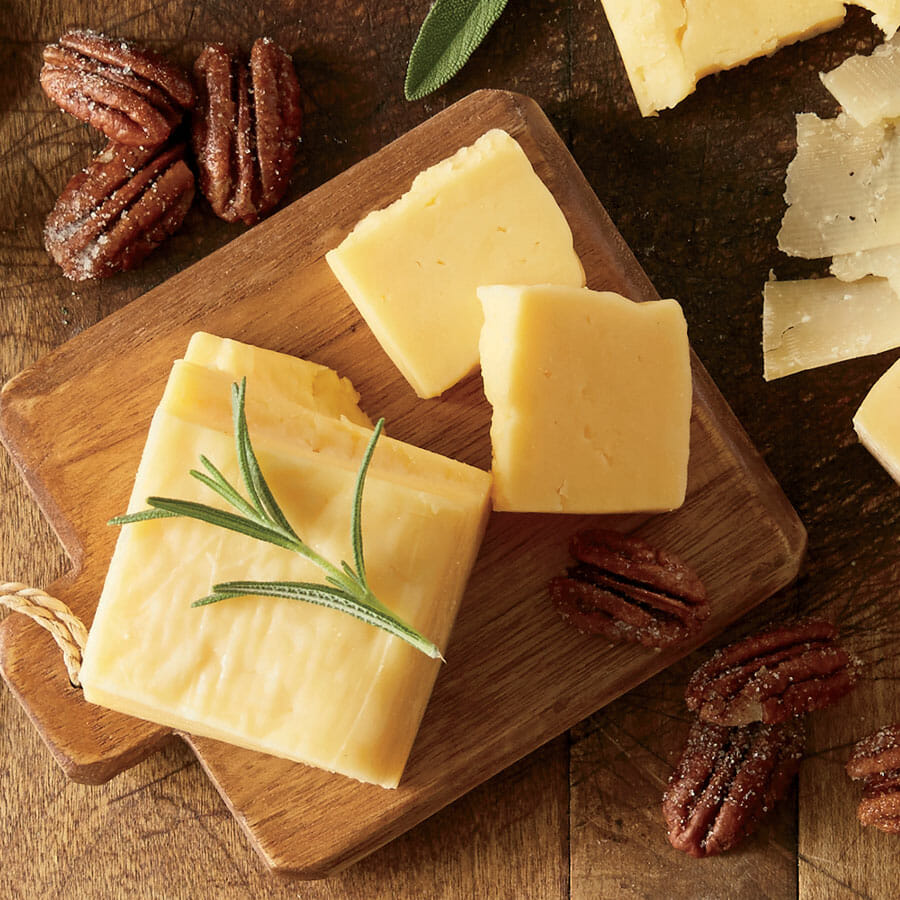
OK, let’s say you’re not doing anything fancy and can’t afford Champagne for your celebration. Champagne, after all, legally refers only to those sparkling wines made in the traditional méthode champenoise from certain grapes in the Champagne region of France. Not to worry: these pairings are perfectly fine with other sparkling wines, like Spain’s cava, Italy’s prosecco or Asti spumante, or, of course, California sparkling wine (no longer called “champagne” as of 2006).
There are a few differences, mostly depending on the dryness of the wine. Brut Champagnes are the driest, and the best brut Champagne cheese pairing is brie. If you’re drinking Italian, remember that prosecco is drier and Asti spumante—made with moscato grapes—is sweeter. So the best cheese to eat with prosecco is the same brie or Camembert you would serve with Champagne…although prosecco and Parmesan is a renowned pairing. On the other hand, Asti spumante is best with a Gorgonzola-style blue cheese to offset its sweetness.
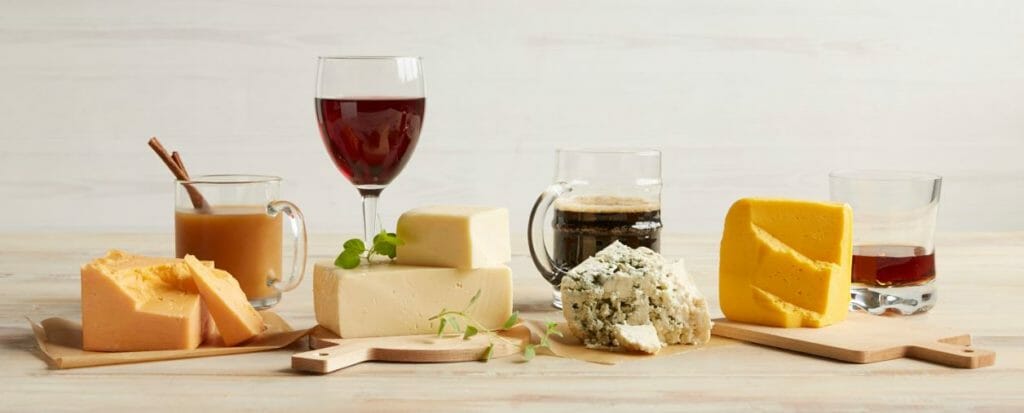
Champagne and Cheese Party Tips
Know your wine dryness scale:
If you’re serving several sparkling wines with a focus on the wines, start with the driest and end with the sweetest. To help you decode the labels, here are the designations from driest to sweetest: brut nature, extra brut, brut, extra dry/extra sec, dry/sec, demi-sec, doux/sweet. As you see, brut is drier than extra dry. These dryness levels pertain to Champagne; other sparkling wines fall somewhere on the scale. Prosecco is available in brut, extra dry and dry.
Serve cheeses in the right order:
This is actually more important than the wine order, since cheeses have such wildly different flavors. As we’ve described in our tips on wine and cheese pairings, start with the mild cheeses (brie) and work your way through the sharper cheeses (Asiago, sharp Cheddar) to the heavy hitters (blue cheeses).
Know your wine glasses:
More and more wine experts are urging us to rethink our choice of glass for sparkling wine. Let’s look at the pros and cons:
- Flute: While the traditional flute helps preserve the bubbles, it does not allow the full aroma of the wine to develop. It does, however, help cut down on spillage during clinking and toasting.
- Coupe: The old-school half-moon glass is très chic if you’re going for the Gatsby look, but it doesn’t preserve effervescence or bouquet. Definitely more substance than style.
- Tulip glass: A good white wine glass is actually your best bet for serving Champagne. It has more of a bowl to allow the wine to breathe and develop aroma, yet is tapered at the top (hence the name “tulip”), which helps preserve the bubbles. Some glasses are flared out at the rim, which is fine. Just remember to use a proper white wine glass, which is smaller than the big-bellied glasses used to serve red wines.
Champagne dinner menu:
If you want to structure a full meal around sparkling wines, here is a suggested multi-course menu. The entire menu will be perfectly delicious with either brut Champagne or Italian prosecco:
- Appetizer: Oysters on the half shell; smoked salmon with onion, capers, whole-grain crackers.
- Main course: Shrimp or lobster with fettucine Alfredo. In Italy, pasta or risotto is eaten as a first course, or primi; the entrée (secondi) is eaten next. Feel free to separate them in this fashion, and to serve prosecco or Champagne with both courses.
- Cheese course: Serve brie with Champagne or blue cheese with Asti spumante. Both are equally delicious with prosecco, if you’d like to simplify the wine selection.
Remember, you don’t have to spend a ton of money to enjoy Champagne or other sparkling wines. The right choice of foods (including cheese, of course) and a little attention to style details will make your Champagne and cheese party a success.

